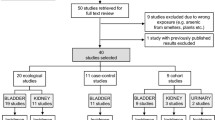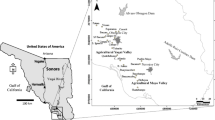Abstract
Objective
Methods and results are presented for an arsenic exposure assessment integral to an epidemiological case–control study of arsenic and cancer—the European Commission funded ASHRAM (Arsenic Health Risk Assessment and Molecular Epidemiology) study carried out in some counties of Hungary, Romania and Slovakia.
Methods
The exposure history of each participant (N = 1,392) was constructed by taking into account how much water they consumed (as water, in drinks and in food), sources of drinking water in their various residences over their lifetime, and the concentrations of arsenic in their various water supplies measured by Hydride Generation-Atomic Absorption Spectrometry (HG-AAS). Concentrations of arsenic in previous water supplies were either derived from contemporary analyses of the same source, or from routine historical data from measurements performed by the authorities in each country. Using this approach, 80% of the recorded lifetime residential history was matched to an arsenic concentration. Seven indices of current, life time, and peak exposure were calculated.
Results
The exposure indices were all log-normally distributed and the mean and median lifetime average concentrations were in Hungary 14.7 and 13.3 μg l−1, Romania 3.8 and 0.7 μg l−1 and in Slovakia 1.9 and 0.8 μg l−1, respectively. Overall 25% of the population had average concentrations over 10 μg l−1 and 8% with exposure over 50 μg l−1.
Conclusions
Careful assessment of arsenic in drinking water supplies (both current and previous) enabled the majority of study participants’ cumulative lifetime of potential exposure to arsenic in residential water to be characterised.


Similar content being viewed by others
References
Abernathy CO, Liu Y-P, Longfellow D, Aposhian HV, Beck B, Fowler B et al (1999) Arsenic: health effects, mechanisms of actions, and research issues. Environ Health Perspect 107:593–597
Babinska K, Bederova A (2002) Changes in nutrient intake in the adult population of the Slovak Republic. J Food Compost Anal 15:359–365
Bates MN, Smith AH, Cantor KP (1995) Case-control study of bladder cancer and arsenic in drinking water. Am J Epidemiol 141(6):523–530
Bates MN, Rey OA, Biggs ML, Hopenhayn C, Moore LE, Kalman D, Steinmaus C, Smith AH (2004) Case-control study of bladder cancer and exposure to arsenic in Argentina. Am J Epidemiol 159(4):381–389
Bidoli E, La Vecchia C, Talamini R, Negri E, Parpinel M, Conti E, Montella M, Carbone MA, Franceschi S (2001) Micronutrients and ovarian cancer: a case-control study in Italy. Ann Oncol 12(11):1589–1593
Bidoli E, Bosetti C, La Vecchia C, Levi F, Parpinel M, Talamini R, Negri E, Maso LD, Franceschi S (2003) Micronutrients and laryngeal cancer risk in Italy and Switzerland: a case-control study. Cancer Causes Control 14(5):477–484
Bidoli E, Talamini R, Bosetti C, Negri E, Maruzzi D, Montella M, Franceschi S, La Vecchia C (2005) Macronutrients, fatty acids, cholesterol and prostate cancer risk. Ann Oncol 16(1):152–157
Biro G (1992) First Hungarian representative nutrition survey: 1985–1988, vol 1. Budapest, Hungary, OTH, NEVI, OETI
Cheng Z, Vangeen A, Seddique AA, Ahmed KM (2005) Limited temporal variability of arsenic concentrations in 20 wells monitored for 3 years in Araihazar, Bangladesh. Environ Sci Technol 39:4759–4766
Chiou HY, Chiou ST, Hsu YH, Chou YL, Tseng CH, Wei ML, Chen CJ (2001) Incidence of transitional cell carcinoma and arsenic in drinking water: a follow-up study of 8, 102 residents in an arseniasis-endemic area in northeastern Taiwan. Am J Epidemiol 153(5):411–418
Colt JS, Baris D, Clark SF, Ayotte JD, Ward M, Nuckols JR et al (2002) Sampling private wells at past homes to estimate arsenic exposure: a methodological study in New England. J Expo Anal Environ Epidemiol 12:329–334
Csanady M, Pinter A, Rudnai P, Bozsai G, Karpati Z (2001) Arsenic in drinking water in Hungary. Report by the National Institute of Public Health, Budapest (unpublished)
Decarli A, Franceschi S, Farraroni M, Gnagnarella O, Parpinal MT, La Vecchia C et al (1996) Validation of a food frequency questionnaire to assess dietary intakes in cancer studies in Italy. Results for specific nutrients. Ann Epidemiol 6:110–118
Ershow AG, Cantor KP (1989) Total water and tapwater intake in the United States: population-based estimates of quantities and sources: Federation of American Societies for Experimental Biology, Life Sciences Office, Bethesda, MD, USA
Ershow AG, Brown LM, Cantor KP (1991) Intake of tapwater and total water by pregnant and lactating women. Am J Public Health 81:328–334
Franceschi S, Negri E, Salvini S, Declari A, Farraroni M, Filiberti R et al (1993) Reproducibility of an Italian food frequency questionnaire for cancer studies: results for specific food items. Eur J Cancer 29A:2298–2305
Franceschi S, Barbone F, Negri E, Decarli A, Ferreroni M, Filiberti R et al (1995) Reproducibility of an Italian food frequency questionnaire for cancer studies: results for specific nutrients. Ann Epidemiol 5:69–75
Franceschi S, Bidoli E, Negri E, Zambon P, Talamini R, Ruol A, Parpinel M, Levi F, Simonato L, La Vecchia C (2000) Role of macronutrients, vitamins and minerals in the aetiology of squamous-cell carcinoma of the oesophagus. Int J Cancer 86(5):626–631
Gleick PH (1996) Basic water requirements for human activities: meeting basic needs. Water Int 21:83–92
IARC (International Agency for Research on Cancer) (2002) Some Drinking-water Disinfectants and Contaminants, Including Arsenic. IARC Monograph 84. IARC, Lyon
Lewis DR, Southwick JW, Ouellet-Hellstrom R, Rench J, Calderon RL (1999) Drinking water arsenic in Utah: a cohort mortality study. Environ Health Perspect 107(5):359–365
Lindberg A, Goessler W, Gurzau E, Koppova K, Rudnai P, Kumar R, Fletcher T, Leonardi G, Slotova K, Gheorghiu E, Vahter M (2006) Arsenic exposure in Hungary, Romania and Slovakia. J Environ Monit 8(1):203–208
Meliker JR, Slotnick MJ, Avruskin GA, Kaufmann A, Fedewa SA, Goovaerts P, Jacquez GJ, Nriagu JO (2007) Individual lifetime exposure to inorganic arsenic using a space-time information system. Int Arch Occup Environ Health 80(3):184–197
Mihailescu M, Daghie V, Dumitrache S (1981) Metodologia Investigatiei. Alimentia si starea de nutritie a populatiei rurale, Ministerul Sanatatii. Bucaresti
National Research Council (2001) Arsenic in drinking water: 2001 update. Subcommittee to update the 1999 arsenic in drinking water report, committee on toxicology, Board on Environmental Studies and Toxicology, National Research Council
Negri E, Franceschi S, Bosetti C, Levi F, Conti E, Parpinel M, La Vecchia C (2000) Selected micronutrients and oral and pharyngeal cancer. Int J Cancer 86(1):122–127
Petrovici DA, Ritson C (2000) Food composition patterns in Romania. Br Food J 102:290–307
Rapant S, Vrana K, Bodis D (1996) Geochemical Atlas of Slovakia: part 1 groundwater: Ministry of Environment of the Slovak Republic, Geological Survey of Slovak Republic, Bratislava, Slovak Republic
Rónai A (1985) The quaternary of the Great Hungarian Plain. Geologica Hungarica 21. Institutum Geologicum Hungaricum, Budapest
Roseberry AM, Burmaster DE (1992) Lognormal distribution for water intake by children and adults. Risk Anal 12:99–104
Ryan PB, Huet N, MacIntosh DL (2000) Longitudinal investigation of exposure to arsenic, cadmium, and lead in drinking water. Environ Health Perspect 108:731–735
Shimokura GH, Savitz DA, Symanski E (1998) Assessment of water use for estimating exposure to tap water contaminants. Environ Health Perspect 106:55–59
Statistical Office of the Slovak Republic (2002) Statisticky urad Slovenskey Republiky. Food consumption in the Slovak Republic (preliminary data), Bratislava
Steinmaus C, Yuan Y, Bates MN, Smith AH (2003) Case-control study of bladder cancer and drinking water arsenic in the Western United States. Am J Epidemiol 158(12):1193–1201
Swan SH, Waller K (1998) Disinfection by-products and adverse pregnancy outcomes: what is the agent and how should it be measured? Epidemiology 9:479–481
Szostak WB, Sekuła W (1991) Nutritional implications of political and economic changes in Eastern Europe. Proc Nutr Soc 50(3):687–693
USDA (United States Department of Agriculture) (1995) Food and nutrient intakes by individuals in the United States, 1 day, 1989-91: United States Department of Agriculture, Agricultural Research Service, NFS Report No. 91-2
USEPA (1997) Exposure factors handbook: National Centre for Environmental Assessment, Office of Research and Development, Washington, DC, USA. EPA\600\P-95\002Fabc, August 1997
USEPA (United States Environmental Protection Agency) (2000) Estimated per capita water ingestion in the United States: Office of Science and Technology, Office of Water, Washington, DC, USA
Varsányi I, Fodré Z, Bartha A (1991) Arsenic in drinking water and mortality in the Southern Great Plain, Hungary. Environ Geochem Health 13:14–22
WHO (World Health Organization) (2001) Arsenic and arsenic compounds (Environmental Health Criteria; 224). International Programme on Chemical Safety, World Health Organization
Williams BL, Florenz Y, Pettygrove S (2001) Inter- and intra-ethnic variation in water intake, contact, and source estimates among Tucson residents: Implications for exposure analysis. J Expo Anal Environ Epidemiol 11:510–521
Acknowledgments
We acknowledge financial support from the European Commission, contract QLK4-CT-2001-00264 (ASHRAM). We thank the participants in the ASHRAM project, and experts in the water authorities in Hungary, Slovakia and Romania.
Conflict of interest
The authors declare that they have no conflict of interest.
Author information
Authors and Affiliations
Corresponding author
Appendix
Appendix
Archived measurements of arsenic in drinking water in Hungary and Slovakia
In Hungary the detailed data, on which the historical estimates were based, were derived from the following data sources summarising arsenic concentrations measured by different laboratories (the majority by the National Institute of Environmental Health (previously called as National Institute of Public Health, NIPH)):
-
The data found in the original logbooks of the instruments used in the NIPH in the 1980s were entered into an electronic database
-
The data stored on paper records at the Békés County Public Health Institute were also entered into an electronic database
-
A study document prepared some years ago by Dr Csanády (National Institute of Environmental Health, Budapest) on the history of the assessment of arsenic exposure via drinking water, the various types of interventions and their results, contained data on concentrations of arsenic before and after remediation in 70 settlements
-
The full database of a country-wide survey on arsenic content of piped drinking water carried out between 1997 and 1999
-
Data from more recent measurements in various settlements where changes in the source(s) of drinking water had occurred.
A list of settlements of residence reported in the questionnaires was created, and Institute staff, drawing on the above resources, provided the concentration profile each year from 1980 to the present, for each community water supply. This table was then sent to the four County Public Health Institutes for comments. As a result, some further changes were performed and the final archive database was again approved by the County Public Health Institutes.
In Slovakia, the State Health Institutes and the Middle and West Slovakia Waterworks and Sewerage Authorities, had established a database of arsenic concentrations in public water supplies covering the period 1989–2004 including about 1,500 results. Further results were available for the public water supplies where concentrations of arsenic had been significantly reduced due to measures realised after the change of the As limit value to 10 μg l−1 (Decree of Ministry of Health of the Slovak Republic). The database was matched to each residential area included in the study (330 residencies).
Rights and permissions
About this article
Cite this article
Hough, R.L., Fletcher, T., Leonardi, G.S. et al. Lifetime exposure to arsenic in residential drinking water in Central Europe. Int Arch Occup Environ Health 83, 471–481 (2010). https://doi.org/10.1007/s00420-010-0519-1
Received:
Accepted:
Published:
Issue Date:
DOI: https://doi.org/10.1007/s00420-010-0519-1




